
Biddeford is a city in York County, Maine, United States. It is the principal commercial center of York County. The population was 21,277 at the 2010 census. Twin city of Saco, Biddeford includes the resort community of Biddeford Pool, Fortunes Rocks and Granite Point. The town is the site of the University of New England and the annual La Kermesse Franco-Americaine Festival. First visited by Europeans in 1616, it is the site of one of the earliest European settlements in the United States.

A lifeguard is a rescuer who supervises the safety and rescue of swimmers, surfers, and other water sports participants such as in a swimming pool, water park, beach, spa, river and lake. Lifeguards are trained in swimming and CPR/AED first aid, certified in water rescue using a variety of aids and equipment depending on requirements of their particular venue. In some areas, lifeguards are part of the emergency services system to incidents and in some communities, lifeguards may function as the primary EMS provider.

The United States Life-Saving Service was a United States government agency that grew out of private and local humanitarian efforts to save the lives of shipwrecked mariners and passengers. It began in 1848 and ultimately merged with the Revenue Cutter Service to form the United States Coast Guard in 1915.

Wood Island Light is an active lighthouse on the eastern edge of Wood Island in Saco Bay, on the southern coast of Maine. The light is just outside the entrance to Biddeford Pool and the end of the Saco River. The lighthouse is a 47-foot (14 m) conical white tower of granite rubble. The light itself sits 71 feet (22 m) above mean high water. Its automated beacon alternates between green and white every 10 seconds.

Biddeford Pool is a large tidal pool, located off Saco Bay south of the mouth of the Saco River on the south coast of Maine. It is approximately 6 miles southeast of downtown Biddeford, to which it is connected via State Route 208. The town of Kennebunkport is 3 miles southwest, connected via State Route 9.

The Virginia Beach Surf & Rescue Museum honors and preserves the history of Virginia's maritime heritage, coastal communities, the United States Lifesaving Service, and the United States Coast Guard along the Atlantic coast.
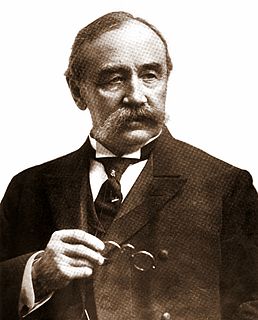
Sumner Increase Kimball was the organizer of the United States Life-Saving Service and the General Superintendent of the Life-Saving Service from 1878–1915. Originally a lawyer and a legislative administrator, Kimball spent his life creating and leading the Life-Saving Service, one of the predecessor services that eventually became the US Coast Guard, transforming it from an uneven collection of facilities round the US coastline into a coherent and well-trained organization.

North Manitou Island Lifesaving Station, also known as North Manitou Coast Guard Station, is a complex of buildings located on North Manitou Island, which is part of Sleeping Bear Dunes National Lakeshore in Michigan, in the U.S. The complex was constructed as a life-saving station. It is the only remaining station which was in use during all three periods of lifesaving service history, from the early volunteer period through operation by the United States Life-Saving Service and the United States Coast Guard. It was declared a National Historic Landmark in 1998.
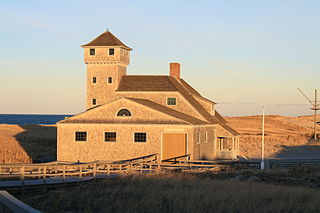
The Old Harbor U.S. Life Saving Station is a historic maritime rescue station and museum, located at Race Point Beach in Provincetown, Massachusetts. Built in 1897, it was originally located at Nauset Beach near the entrance to Chatham Harbor in Chatham, Massachusetts. It was used by the United States Life-Saving Service (USLSS), and then by its successor, the United States Coast Guard (USCG), as the Old Harbor Coast Guard Station. The station was decommissioned in 1944, abandoned and sold as surplus in 1947, and was used as a private residence for the next twenty-six years.
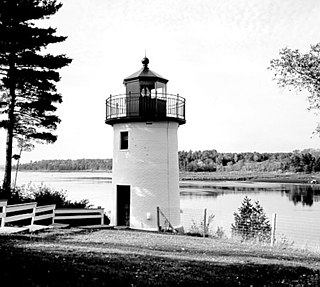
The Whitlocks Mill Light is a lighthouse on the south bank of the St. Croix River in Calais, Maine. It is the northernmost lighthouse in the state of Maine, and was the last light to be built in the state.

The National Harbor of Refuge and Delaware Breakwater Historic District encompasses a series of seacoast breakwaters behind Cape Henlopen, Delaware, built between 1828 and 1898 to establish a shipping haven on a coastline that lacked safe harbors. The Harbor of Refuge is at the mouth of the Delaware Bay estuary where it opens into the Atlantic Ocean, at Lewes.

Great Duck Island Light is a lighthouse on Great Duck Island in the town of Frenchboro, Maine, USA. Established in 1890, the light marks the approach to Blue Hill Bay and the southern approaches to Mount Desert Island on the central coast of Maine. The light was listed on the National Register of Historic Places as Great Duck Island Light Station on March 14, 1988. The light is an active aid to navigation maintained by the United States Coast Guard; the property is owned by the College of the Atlantic, which operates a research station there.

Grindel Point Light is a lighthouse in Islesboro, Maine, marking the west entrance to Gilkey Harbor at the westernmost point of the eponymous island. The light station was established in 1850, and the present tower and keeper's house were built in 1874. The station was deactivated in 1934 and reactivated in 1987. It was listed on the National Register of Historic Places in 1987. The keeper's house now houses the Grindel Point Sailor's Museum and the lighthouse tower is open for tours in the summer.
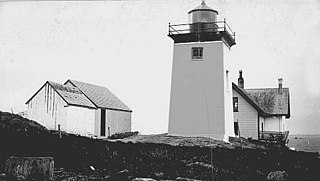
Indian Island Light is a lighthouse on Indian Island on the eastern side of the entrance to Rockport Harbor, Maine. It was first established in 1850. The present structure was built in 1875. It was deactivated in 1934 and is now a private residence. It was listed on the National Register of Historic Places as Indian Island Light Station on March 23, 1988.

The Damariscove Lifesaving Station is a historic coastal maritime rescue facility, located on Damariscove Island in Boothbay, Maine. The station was built in 1897, and is one of the more architecturally distinguished of the surviving stations. It was listed on the National Register of Historic Places on June 25, 1987. It is now privately owned.
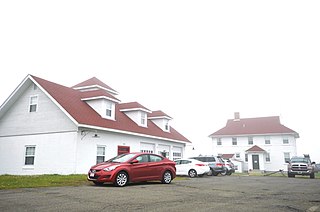
West Quoddy Lifesaving Station is a historic coastal rescue station on West Quoddy Head in Lubec, Maine. The lifesaving station was built in 1919, and was operated by the United States Coast Guard until 1972. It was listed on the National Register of Historic Places on April 20, 1990. It now houses a bed and breakfast inn.

The Indian River Life-Saving Station was established at Rehoboth Beach, Delaware in 1876 to rescue mariners shipwrecked along the Delaware coast, as part of the United States Life-Saving Service. It was designed in 1874 as a 1-1/2-story board-and-batten frame structure with decorative brackets supporting overhanging eaves in a version of the Queen Anne style. It sheltered a surfboat which could be quickly rolled out through double doors facing the beach and down a ramp to the water. The main station house remains of what was once a complex that included a barn, stable, meat house, feed house and privy. An auxiliary boathouse stood about a mile to the south. The original plans for the station survive.

The Eagle Harbor Coast Guard Station Boathouse is a boathouse located at 9282 Marina Road in Eagle Harbor, Michigan. It was listed on the National Register of Historic Places in 2012.

The Whitehead Lifesaving Station was a maritime rescue facility on Whitehead Island, an island off the coast of St. George, Maine at the mouth of Penobscot Bay. Established in 1874 by the United States Life-Saving Service, its original building is one of the best-preserved of the five stations built by the service on the coast of Maine and New Hampshire at that time. The station was in active use until the 1940s, and is now privately owned. It was listed on the National Register of Historic Places in 1988.

The Ocean City Life-Saving Station is the only life-saving station of its design in New Jersey still in existence. Designed by architect James Lake Parkinson in a Carpenter Gothic style, the building is one of 25 stations built of the 1882 life-saving type. It is also one of six still in existence in the country. Construction on the facility began in September 1885 and was completed in the following year. There were two earlier stations in the northern end of Ocean City before this facility was constructed, and there were two stations farther south on the island.






















